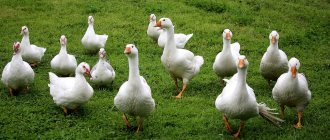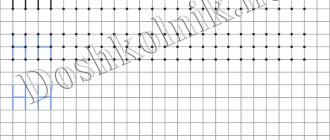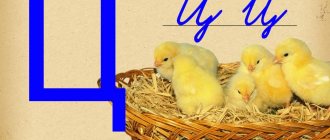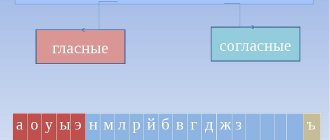"Games with letters"
Prepared by V.V. Minakova, teacher-defectologist.
"Circle the letter ." The adult invites the child to carefully examine, recognize and name the familiar letter that is written in dotted lines, and complete it with “Find the letter.” The adult invites the child to find the letter being studied among other letters written in the same regular font. For example. “T” (can be any) T. P V S M T T K I N V L T L T S B D T S CH E K R T F Y T B T T
"Find the letter ." The adult invites the child to find different images of the letter being studied, which are written in different fonts, among other letters. For example: “Z”. T P Z Sh L X Z R
“Name the letter.” The adult invites the child to find a letter among the letters crossed out in various ways P T V V R S V D I M V H V V T V
"Find the letter ." The adult invites the child to find the letter he named in a series of graphically similar letters, for example, the letter “G”: P G T R T G P P G.
“Complete the letter .” The adult invites the child to carefully examine the familiar unfinished letter, name it and complete the missing elements “Find the mistake.” The adult invites the child to look at two images of the same familiar letter, one of which is written incorrectly. The child must cross out the incorrect picture of the letter “Find out the letter.” The child closes his eyes. At this time, the adult “writes” a letter familiar to him on the child’s hand. The child names which letter the adult “wrote” on his hand.
"Wonderful bag." The adult places three-dimensional letters familiar to the child, made of plastic, cardboard or wood, into an opaque bag. The child, with his eyes closed, takes a letter from the bag, feels it with both hands and names it.
“Fold the letter.” The adult asks the child to put together a whole image from the parts and name the resulting letter. (The card on which a letter familiar to the child is written is cut into several parts.)
“Lay out the letter .” An adult invites the child to lay out a letter familiar to him from various materials: mosaics, seeds, small nuts, seeds, buttons, branches, pieces of paper, counting sticks and thick threads.
"Make a letter ." An adult invites the child to make a letter he is familiar with from plasticine, wire or paper (first according to the model, and then on his own).
"Magic Pencil" The adult invites the child to trace a familiar letter along the contour, shade it in a certain way, or paint it over.
“Write the letter.” The adult invites the child to write a letter he knows with his finger in the air, or with a stick on wet sand or snow.
“Describe the letter .” The adult invites the child to tell what elements the familiar letter consists of and how they are located. For example: the letter "H " consists of two large vertical sticks and one small horizontal stick between them.
"Wizard ". The adult invites the child to lay out some letter familiar to him from counting sticks or bend from wire, and then “transform” it into another, graphically similar letter. “O” from wire and then “turn” it into the letter “C”; lay out the letter “N” from sticks , and then “turn” it into the letter “P” , etc.
Summary of a literacy lesson “Sound [T] and letter T”
Abdulova Dzhume Sirazhutdinovna
Summary of a literacy lesson “Sound [T] and letter T”
Goal : To consolidate children's knowledge about the sound and letter T
Materials: demonstration material, workbooks 1 part, a simple pencil, colored pens and pencils, tumblers, felt-tip pens.
I. Organizational moment
Educator: Guys, listen to the riddle and tell me what sound we will study today
A tiger is the same cat
Just a little wild.
Tiger teaches karate
This is how he learns the letter. (T)
Educator: name the first sound in words and determine what the sound t is
Axe, plate, cake (children's answers), dough, tiger, TV (children's answers)
Educator: That's right, the sounds T (Ть) are heard. The sound T is a consonant, it is not sung and we feel obstacles in our mouth when we pronounce it. This means that the sound T is a consonant, deaf, and can be soft or hard.
Articulation of sound
Let's say the "T" sound together.
II. Main part.
One child does a task at the board. Artem will go to the blackboard today.
(Work in the notebook Elena Astafieva: We play, read, write. Workbook No. 1. Federal State Educational Standard) children write the letter T, paint the roof of the house and the tumbler in blue and green, write the letter T in their pocket.)
1. Game exercise “Put the letter in her apartment”
Objectives: consolidate knowledge about the studied sound and letter; learn to choose the right and left front house, count the floors in order, starting from the bottom; explain the choice of your decision based on knowledge about sound.
Educator: Guys, look, in your notebook you have drawn a house for letters, the owner of this house is a tumbler. Artem settled the letter T on the fourth floor, under the letter P.
Educator: which tumbler do we choose?
Children's answers: blue and green without a bell
Educator: why?
Children's answers: because the sound T is a consonant, the deaf sound can be soft and hard.
1. Game exercise “Find your place”
Goal: to learn to find the place of sounds in words and write the letter T. In the first part, children find the place of the letter using pictures, and in the second part, everyone draws their own picture.
2. Game exercise “Continue according to the example”
Educator: guys, now we do the second exercise, we write the letter T, large and small, in the air with our fingers, then with a pen in a notebook, and to consolidate the knowledge we write 6 in green and 6 in blue.
Goals: consolidate knowledge about sounds and letters. Training a child's visual memory
3. Exercise “Graphic dictation”
Goal: continue according to the example; develop visual memory
4. Exercise “Complete the picture”
Goal: learn to find the image of the letter T and trace the dots of the picture; learn to find words with the sound T in a picture, consolidate knowledge of the lexical topic “Pets”
What mistake did Artem make when decorating the bell, because the sound is dull.
5. Game exercise “Every thing has its place” (“Hanger”)
Goals. We consolidate the general concepts of outerwear, shoes, hats. We learn to find objects in the picture whose names contain the sound T, to determine the place of this sound in a word, its softness or hardness; We consolidate the ability to determine the number of syllables in a word and select its syllabic pattern for the word.
Progress of the game. The child examines and names the objects in the picture, groups these objects according to general characteristics: clothes, shoes, hats; clarifies which of the items did not fall into any group and why. (The bow does not belong to any group of objects, since it is a decoration.) The child explains why all these objects need a hanger and how they are located on it. It is necessary to determine which item of clothing is usually not hung on a hanger in the hallway and where it is stored. (The dress is stored in the closet.) The child uses arrows to indicate where each item will be located on the hanger; paints only those objects whose names contain T (cloak, boots, and hat remain unresolved); determines in which part of the tin the T is located and what type it is (consonant, voiceless, hard or soft).
The child looks at the diagrams under the pictures and explains their meaning. Then, for each diagram, he selects a tin from those proposed in the game, explaining why he chose this particular word for the diagram.
6. Game exercise “Slippers”
Goals. We strengthen the ability to identify the first sound in words and compare it with a letter. We learn to determine the number of syllables in a written word without reading it (identify vowel letters and from this draw a conclusion about the number of syllables in a given word). We consolidate the ability to trace the image of an object by dots.
Progress of the game. The child tries to recognize objects made in a dotted image (sneakers); checks his guess by circling the picture dot by dot and coloring it.
The child identifies the first sound in the word slipper and remembers which letter represents this sound. The adult explains that the word slippers is written next to the picture, but one letter is not written in it. “What letter is missing in the word?” The child must guess, explain why T, and complete the word.
Having examined the written word, the child names the vowels in it in order from left to right and determines the number of syllables, based on the rule: the number of vowels in a word, the number of syllables. The number of syllables can be checked by using your hand to pronounce the word slowly (see page 5). The game “ends with sketching a syllable diagram under the word slipper and writing vowels above it.
Game exercise “Find the hidden letter T”
Goals. We fix the image of the letter T, teach us to distinguish it from a number of similar figures. We train the child to write this letter independently.
Progress of the game. The child examines the proposed figures in the drawing, recognizes T t among them and circles the letters, after which he himself writes down T t in the empty cells, commenting on his movements.






